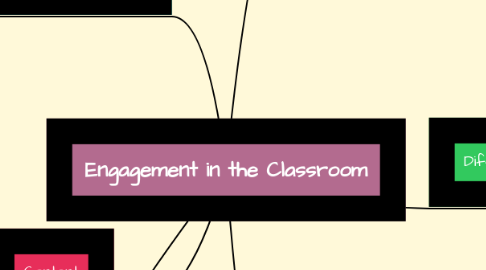
1. Interactive Tools
1.1. Using Movement
1.1.1. Exercise (e.g. yoga)
1.1.2. Asking students to get up and move around during a lesson
1.2. Using Technology
1.2.1. Apps on the iPad
1.2.2. Computer
1.2.3. Smart Board
1.3. Using Hands-On Activities
1.3.1. Dry-Erase Boards
1.3.2. Board Games
1.3.3. Manipulatives
1.4. Using Inquiry-Based Learning
1.4.1. Discussion
1.4.2. Journal Entries
1.4.3. Classroom Debate
1.4.4. Ask Questions
2. Content
2.1. Make it Meaningful
2.2. Background Knowledge
2.3. Connectedness to the World
3. Autonomy Support
3.1. Welcoming Student Opinions
3.1.1. Research and prepare experiment
3.2. Giving Students the time to need to undertsand
3.3. Student-Centered Learning
3.3.1. Projects
3.3.2. Role Play
3.3.3. Small Group
4. Learning Environment
4.1. Sense of Community
4.1.1. Safe
4.1.2. Affirmining
4.1.3. Respect for Individual
4.1.4. Respect for Group
4.2. Physical Space
4.2.1. Using Cushions
4.2.2. Using Exercise Balls
4.2.3. Including a Quiet Space
4.2.4. Standing Table, Round Table
4.2.5. Visuals
4.3. Collaboration
4.3.1. Cooperative Learning Groups
4.3.2. Learning Centers
4.3.3. Think-Pair-Share
5. Differentiation
5.1. Flexible
5.1.1. Time
5.1.2. Groups
5.1.2.1. Centers
5.1.2.2. Peer-Teaching
5.1.3. Resource
5.1.3.1. Videos
5.1.3.2. Games
5.1.3.3. Reading
5.2. Continual Assessment
5.2.1. Pre-assessment to understand student's interest, readiness, and learning style.
5.2.2. On going feedback and grading
5.2.3. On going assessment
5.2.4. Self and peer assessment
5.3. Instructional Strategies
5.3.1. Graphic Organizers
5.3.2. Concept Maps
5.3.3. Scaffolded Reading
5.3.4. Learning Centers
